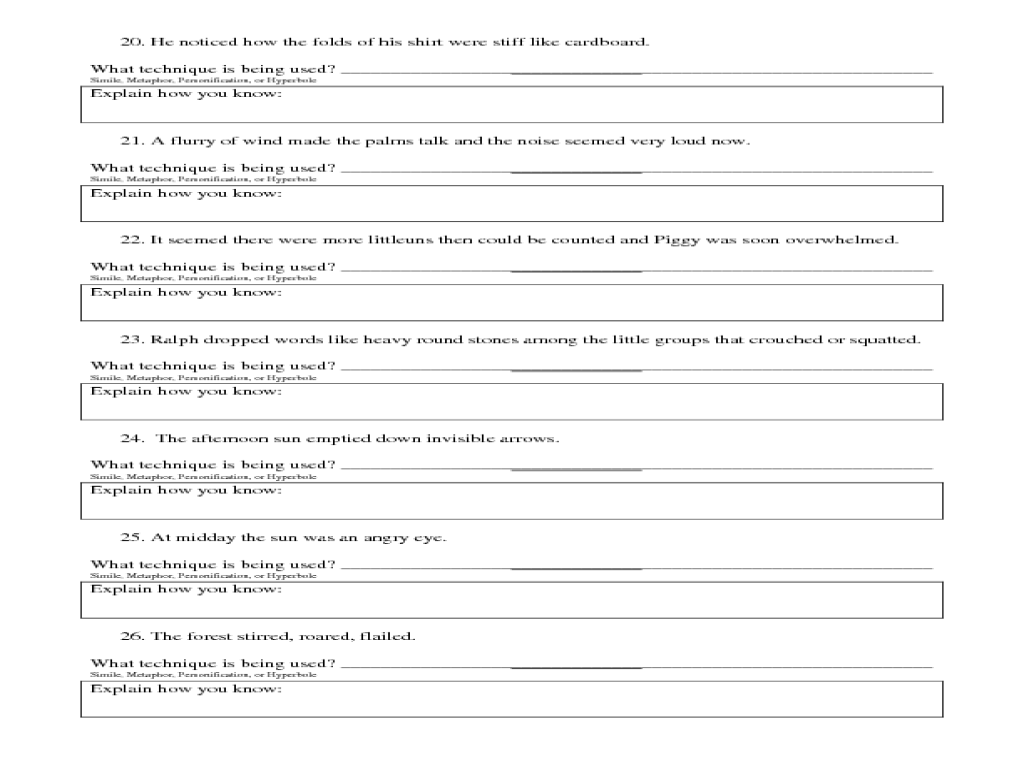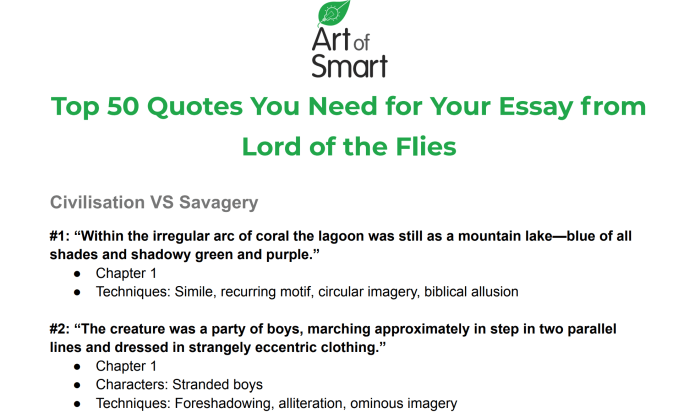Lord of the flies figurative language – In William Golding’s classic novel, Lord of the Flies, figurative language plays a pivotal role in unveiling the complexities of human nature. Through symbolism, allegory, metaphor, simile, and personification, Golding masterfully constructs a microcosm of society, exposing the dangers of unchecked human nature and the struggle between civilization and savagery.
The island setting, with its lush vegetation and hidden dangers, serves as a potent symbol of the untamed wilderness within the human psyche. The conch, a symbol of order and civilization, gradually loses its power as the boys descend into chaos, highlighting the fragility of human institutions.
Symbolism
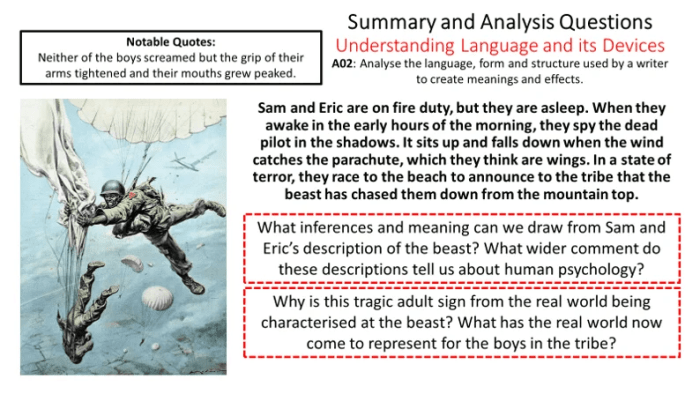
In Lord of the Flies, the island serves as a microcosm of society, reflecting the complexities and conflicts that arise when individuals are left to their own devices.
The conch, a large seashell, symbolizes order and civilization. When it is blown, the boys are called to assemblies and are expected to follow the rules established by the group. The conch represents the fragile nature of democracy and the importance of adhering to agreed-upon laws.
The Fire as a Symbol of Destruction and Hope
The fire, initially a source of warmth and comfort, becomes a symbol of both destruction and hope. When the boys accidentally set the island ablaze, it represents their loss of innocence and the destructive power of unchecked passions. However, the fire also becomes a beacon of hope, as it attracts a passing ship and leads to their rescue.
Allegory
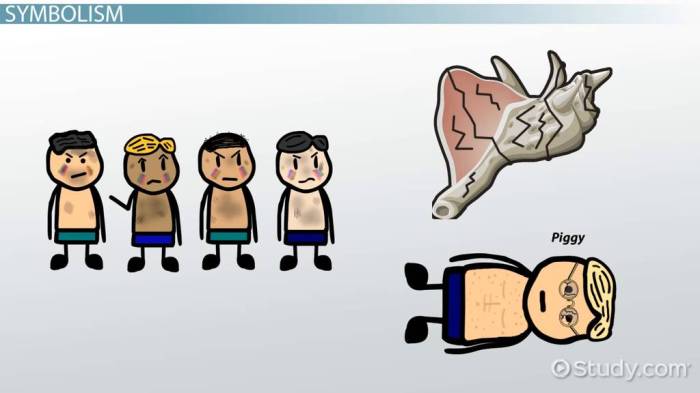
Lord of the Fliescan be read as an allegory of human nature, exploring the inherent savagery and potential for violence that lies within all individuals. The novel’s characters represent different aspects of human nature, and their interactions illustrate the dangers of unchecked human impulses.
The central conflict of the novel arises when a group of British schoolboys are stranded on a deserted island after their plane crashes. Initially, the boys attempt to maintain a semblance of order and civilization, but as time goes on, their primal instincts begin to emerge.
Characters as Allegories
The characters in Lord of the Fliesrepresent different aspects of human nature. Ralph represents the rational and civilized side of humanity, while Jack represents the savage and impulsive side. Piggy represents intellect and reason, while Simon represents spirituality and insight. The other boys represent the masses who are easily swayed by the charismatic Jack.
Dangers of Unchecked Human Nature
The novel’s message about the dangers of unchecked human nature is clear. When left to their own devices, humans will inevitably descend into savagery and violence. This is because human nature is inherently flawed, and without the constraints of civilization, our darker impulses will take over.
The novel’s ending is a cautionary tale about the importance of maintaining a balance between our civilized and savage impulses. If we allow our savage impulses to dominate, we will destroy ourselves.
Metaphor
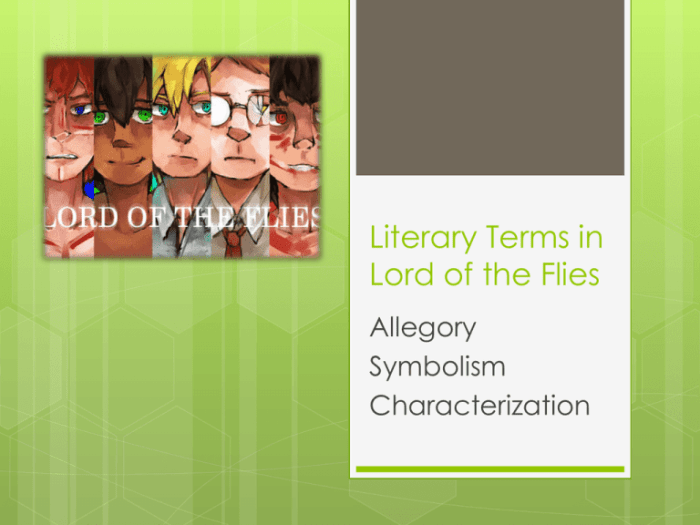
Metaphors are a type of figurative language that compare two unlike things without using the words “like” or “as.” They are used to create vivid images and to make complex ideas more concrete and relatable.
In Lord of the Flies, William Golding uses metaphors to develop the novel’s themes and characters and to create a sense of atmosphere and mood.
Examples of Metaphors
- The island as a microcosm of society:The island represents the world in miniature, with its own rules, hierarchies, and conflicts.
- The conch as a symbol of civilization:The conch represents the conch shell that the boys use to call meetings and maintain order. It is a symbol of the fragile hope for civilization that the boys initially have.
- The beast as a symbol of fear and savagery:The beast is a mysterious creature that the boys believe lives on the island. It represents the fear and savagery that is lurking within the boys themselves.
Metaphor and Theme
Metaphors contribute to the novel’s themes by providing a concrete and relatable way to explore complex ideas. For example, the metaphor of the island as a microcosm of society allows Golding to explore the themes of civilization and savagery.
Metaphor and Character
Metaphors also help to develop the novel’s characters. For example, the metaphor of the beast as a symbol of fear and savagery helps to reveal the inner conflicts of the boys.
Metaphor and Atmosphere, Lord of the flies figurative language
Metaphors can also be used to create a sense of atmosphere and mood. For example, Golding uses the metaphor of the island as a dark and dangerous place to create a sense of suspense and foreboding.
Simile
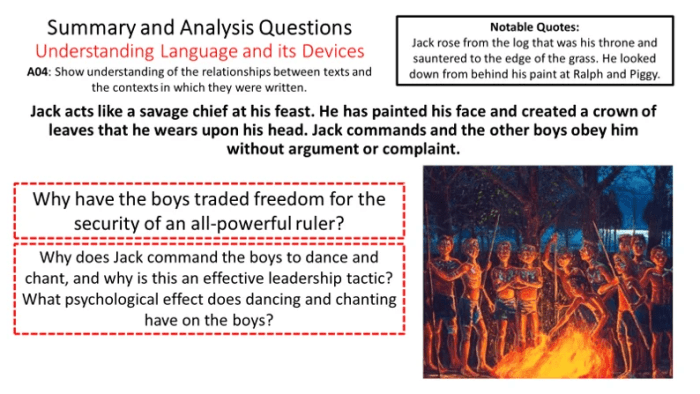
William Golding’s Lord of the Fliesis replete with similes, literary devices that compare two unlike things using the words “like” or “as.” These similes play a crucial role in enhancing the novel’s imagery, descriptions, and sense of realism and immediacy.
Imagery and Descriptions
Similes contribute significantly to the novel’s vivid imagery and descriptive passages. For instance, when describing the boys’ initial excitement upon arriving on the island, Golding writes: “The lagoon was dazzlingly blue and still as a mountain lake.” This simile compares the lagoon to a mountain lake, evoking images of tranquility and serenity.
Realism and Immediacy
Similes also serve to create a sense of realism and immediacy. By comparing unfamiliar or abstract concepts to familiar objects or experiences, Golding makes the events and characters in the novel more relatable and tangible. For example, he describes the boys’ fear of the beast as “a beast with claws that scratched, with teeth that bit, a beast with a roar that made the cheekbones ache.”
This simile vividly conveys the boys’ terror by likening it to a physical sensation.
Personification: Lord Of The Flies Figurative Language
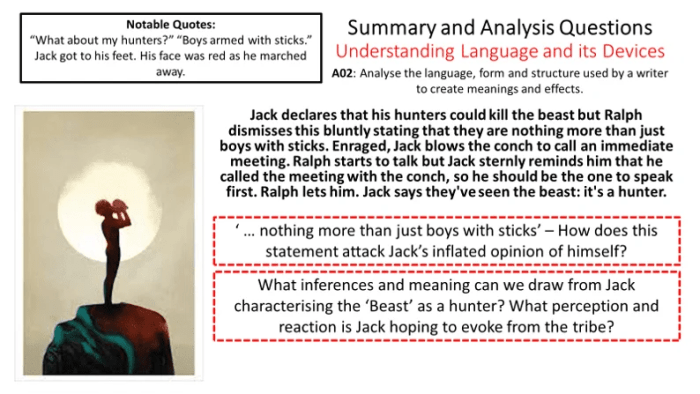
Personification is a literary device that gives human characteristics to non-human things. In Lord of the Flies, William Golding uses personification to create a vivid and immersive world that reflects the complex nature of human society.
One of the most striking examples of personification in the novel is the use of the island itself as a character. The island is described as a “living thing,” with a “heart” and a “soul.” It is also described as a “monster,” which reflects the dangers and challenges that the boys face on the island.
Characterization
Personification also plays a significant role in the characterization of the boys. For example, Ralph is often described as a “leader,” while Piggy is described as a “thinker.” These personifications help to define the roles that the boys play in the group and to highlight their individual strengths and weaknesses.
Themes
Personification also contributes to the novel’s themes. For example, the personification of the island as a “monster” reflects the theme of the savagery of human nature. The personification of the boys as “hunters” and “savages” reflects the theme of the loss of innocence.
Empathy and Connection
Finally, personification can be used to create a sense of empathy and connection between the reader and the characters. By giving human characteristics to non-human things, the author can make the reader more invested in the story and more sympathetic to the characters.
FAQs
How does the use of symbolism contribute to the novel’s themes?
Symbolism allows Golding to explore abstract concepts through concrete objects, enriching the novel’s themes and creating a deeper level of understanding.
What is the significance of the conch as a symbol of order?
The conch represents the fragile hope for civilization and order amidst the chaos of the island. Its gradual deterioration symbolizes the boys’ descent into savagery.
How does the use of metaphors enhance the novel’s atmosphere?
Metaphors create vivid imagery and sensory experiences, immersing readers in the novel’s setting and enhancing its emotional impact.
